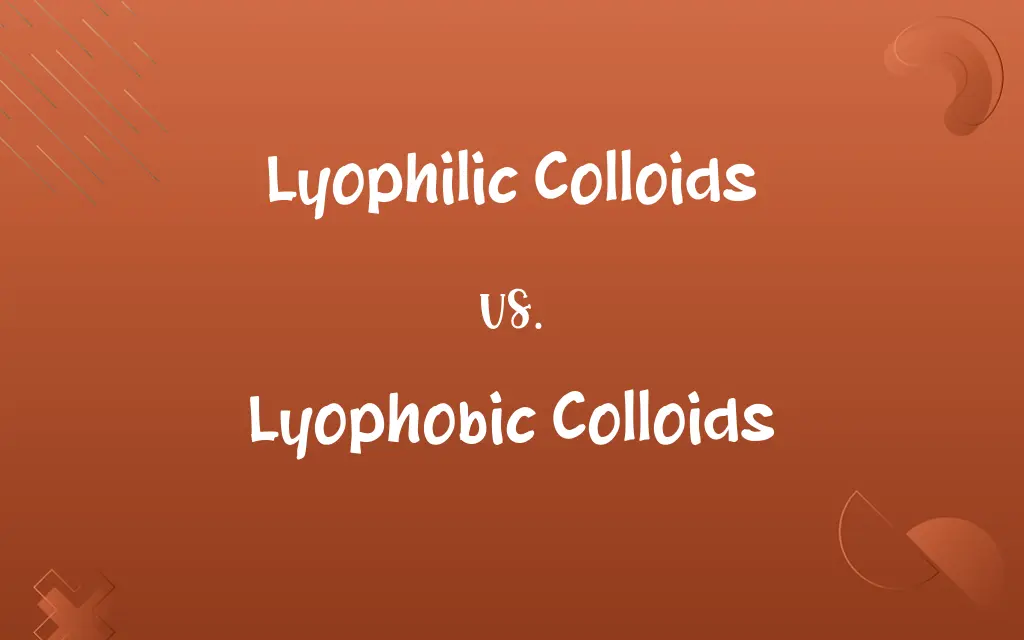Lyophilic Colloids vs. Lyophobic Colloids: Know the Difference

By Dua Fatima & Hifza Nasir || Published on March 6, 2024
Lyophilic colloids are solvent-attracting, easy to prepare, and stable; lyophobic colloids require special conditions for formation and are less stable but have unique applications.

Key Differences
Lyophilic colloids, characterized by their affinity for the solvent, are inherently stable and easy to reconstitute after drying. They typically consist of large molecules or polymers that form spontaneous and reversible colloidal solutions, making them ideal for biological applications. Lyophobic colloids, in contrast, are solvent-repelling and require specific conditions such as high energy or stabilizers to form. They are less stable and more sensitive to electrolytes but are essential in industrial processes due to their unique properties.
Hifza Nasir
Mar 06, 2024
The preparation of lyophilic colloids is straightforward, as they naturally disperse in their preferred solvent without needing special treatments. This inherent compatibility with the solvent contributes to their stability against coagulation and sedimentation. Lyophobic colloids, however, demand vigorous agitation, ultrasonic energy, or the addition of stabilizing agents to maintain dispersion, reflecting their sensitivity and potential for irreversible aggregation.
Dua Fatima
Mar 06, 2024
In terms of stability, lyophilic colloids are less affected by the addition of electrolytes or changes in pH, owing to their strong interaction with the solvent. Lyophobic colloids can easily coagulate when electrolytes are introduced, due to the reduction of repulsive barriers between particles, necessitating careful control over environmental conditions to maintain stability.
Dua Fatima
Mar 06, 2024
The reversible nature of lyophilic colloids allows them to be easily recovered and redispersed after removal of the solvent, showcasing their flexibility in various applications. Lyophobic colloids lack this reversibility, making their production and handling more challenging but also enabling the creation of finely tuned materials with specific characteristics for technological and industrial uses.
Hifza Nasir
Mar 06, 2024
Despite these differences, both types of colloids play crucial roles across a wide range of fields, from pharmaceuticals and food science to materials engineering and environmental technology, highlighting the diversity of colloidal systems and their applications.
Shumaila Saeed
Mar 06, 2024
ADVERTISEMENT
Comparison Chart
Preparation
Easy, spontaneous dispersion.
Requires energy or stabilizers for dispersion.
Dua Fatima
Mar 06, 2024
Stability
High, resistant to coagulation and sedimentation.
Low, sensitive to electrolytes and conditions.
Dua Fatima
Mar 06, 2024
Reversibility
Reversible, can be easily redispersed after drying.
Irreversible, difficult to redisperse after coagulation.
Hifza Nasir
Mar 06, 2024
Sensitivity to Electrolytes
Low, stable in the presence of electrolytes.
High, coagulates easily with electrolytes.
Dua Fatima
Mar 06, 2024
ADVERTISEMENT
Applications
Pharmaceuticals, biotechnology, food science.
Paints, ceramics, water purification, pharmaceuticals.
Hifza Nasir
Mar 06, 2024
Lyophilic Colloids and Lyophobic Colloids Definitions
Lyophilic Colloids
Suitable for biological applications due to compatibility.
Polysaccharides form lyophilic colloids for drug delivery systems.
Dua Fatima
Feb 29, 2024
Lyophobic Colloids
Irreversible aggregation without stabilizers.
Gold nanoparticles in lyophobic colloids are stabilized for medical imaging.
Dua Fatima
Feb 29, 2024
Lyophilic Colloids
Resistant to coagulation, allowing easy recovery.
Proteins in aqueous solutions maintain stability as lyophilic colloids.
Dua Fatima
Feb 29, 2024
Lyophobic Colloids
Essential in industrial and technological applications.
Silica colloids in paints enhance durability and texture.
Dua Fatima
Feb 29, 2024
ADVERTISEMENT
Lyophilic Colloids
Solvent-loving colloids, stable and easy to prepare.
Gelatin in water forms a lyophilic colloid, used in food and pharmaceuticals.
Hifza Nasir
Feb 29, 2024
Lyophobic Colloids
Solvent-repelling colloids, require energy for dispersion.
Silver nitrate reduced to silver particles forms a lyophobic colloid used in photography.
Hifza Nasir
Feb 29, 2024
Lyophilic Colloids
Naturally dispersible without special treatment.
Starch dispersion in water is a common lyophilic colloid in cooking.
Hifza Nasir
Feb 29, 2024
Lyophobic Colloids
High sensitivity to electrolytes affects stability.
Adding salt can coagulate lyophobic colloidal suspensions, used in purifying processes.
Shumaila Saeed
Feb 29, 2024
Lyophilic Colloids
Exhibits reversibility, enhancing usability.
Pectin can be redispersed in water, showcasing the reversible nature of lyophilic colloids.
Dua Fatima
Feb 29, 2024
Lyophobic Colloids
Prone to coagulation, sensitive to environmental changes.
Iron hydroxide colloids in water are lyophobic, used for wastewater treatment.
Hifza Nasir
Feb 29, 2024
Repeatedly Asked Queries
Can lyophobic colloids be made reversible?
Generally, lyophobic colloids are not reversible after coagulation without specific chemical or physical treatments.
Shumaila Saeed
Mar 06, 2024
How can lyophobic colloids be stabilized?
Through the addition of stabilizing agents, ultrasonic energy, or vigorous mixing to maintain dispersion and prevent coagulation.
Dua Fatima
Mar 06, 2024
What roles do lyophobic colloids play in industry?
They are crucial in manufacturing paints, ceramics, and water purification systems, among other applications.
Dua Fatima
Mar 06, 2024
Why are lyophilic colloids more stable?
Their molecular structure strongly interacts with the solvent, resisting coagulation and sedimentation, thus enhancing stability.
Dua Fatima
Mar 06, 2024
How do electrolytes affect lyophilic and lyophobic colloids?
Lyophilic colloids are less sensitive to electrolytes, while lyophobic colloids can coagulate easily upon their addition.
Dua Fatima
Mar 06, 2024
What is a lyophilic colloid?
A lyophilic colloid is a substance that has a strong affinity for the solvent, forming stable, easily prepared colloidal solutions.
Hifza Nasir
Mar 06, 2024
What is a lyophobic colloid?
A lyophobic colloid is a substance that repels the solvent, requiring special conditions for stable colloidal solution formation.
Hifza Nasir
Mar 06, 2024
What are the applications of lyophilic colloids?
They are widely used in pharmaceuticals, biotechnology, and food science due to their stability and biocompatibility.
Dua Fatima
Mar 06, 2024
What makes a colloid lyophilic or lyophobic?
The molecular interaction between the colloid particles and the solvent determines their lyophilic or lyophobic nature.
Hifza Nasir
Mar 06, 2024
Are there environmental benefits to using colloids?
Yes, colloids play roles in environmental technology, such as water purification and pollution control, by facilitating the removal of contaminants.
Shumaila Saeed
Mar 06, 2024
Share this page
Link for your blog / website
HTML
Link to share via messenger
About Author
Written by
Dua FatimaCo-written by
Hifza Nasir








































































